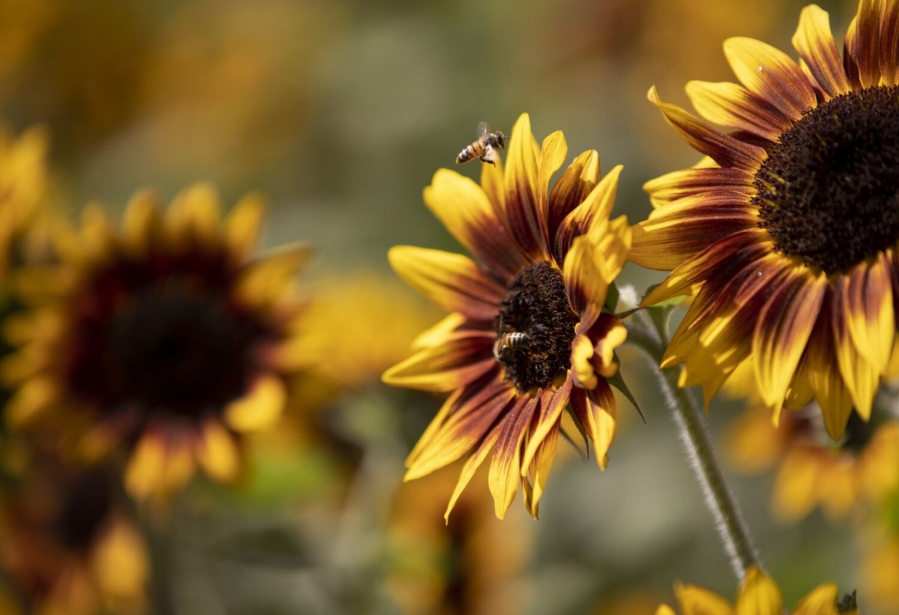SAN DIEGO — San Diego may soon have more rooftop green spaces and community gardens as part of a new campaign to boost the shrinking population of local bees, which serve as crucial pollinators needed to sustain agriculture and ecotourism.
The city is the largest in the nation to become a Bee City USA, a designation that requires creating new habitats for pollinators, adopting policies that prevent habitat destruction and revising pest management plans to use pesticides only as a last resort.
“Bee City USA is not just a designation, it’s a commitment to biodiversity, pollinators and reducing harmful pesticide use,” said City Councilmember Joe LaCava, who spearheaded efforts that culminated with council approval Aug. 1.
San Diego is among more than 150 cities that have made such commitments since an environmental conservation nonprofit called the Xerces Society created the Bee City program 10 years ago. The only other local city to have adopted the designation is Encinitas.
It’s a major boon for bees, which are declining in population worldwide, to have San Diego added to the list of places committed to conservation and community awareness, said UC San Diego ecology professor James Nieh.
“This is a biodiversity hot spot containing a greater diversity of life than any other county in the continental U.S.,” said Nieh, noting that San Diego County also has the greatest number of plant and animal species threatened by extinction.
Nieh said the loss of pollinators can kill off many native species of plant, allowing invasive species that increase wildfire risk to flourish in the city’s canyons and on its hillsides.
The recent loss of pollinators, which also includes some bird species, threatens the region’s agriculture industry, city officials said. Bees are crucial pollinators for avocados, pomegranates, limes and many other local crops, they said.
The county’s avocado industry is estimated to generate more than $150 million in annual revenue, officials said.
The decline in pollinators also threatens the region’s strong economy of ecotourism — people coming to San Diego to hike, bird or otherwise enjoy the natural environment.
“Without an abundance of pollinators, San Diego would not be the major avocado producer or beautiful tourist attraction for which it’s famous,” said Mary Jarvis, educational outreach coordinator for the San Diego Beekeeping Society.
An Ohio State University study in 2020 found that bees, which are responsible for pollinating roughly one-third of the nation’s food supply, have been declining in population at roughly 30 percent a year nationwide in recent years.
Because so many of San Diego’s natural bee habitats and nesting sites have been destroyed by development in recent decades, the city could explore encouraging more “stepping stone” locations to help pollinators move around, said Laura Rost, a national Bee City coordinator.
Those could include green roofs, community gardens and trees on streets. City officials said such efforts could be particularly helpful in urban neighborhoods, including many communities of color that lack parks and have fewer trees and foliage.
The program also requires cities to focus on educational outreach to the public to encourage individual property owners to make their yards more pollinator-friendly.
The program also encourages people to buy organic fruits and vegetables, which are grown without pesticides that threaten bees, and to avoid using pesticides in their own yards.
Another crucial element is that designated bee cities must revise their pest management plans to integrate pollinators more aggressively and to make pesticide use allowable only as a last resort.
But Rost stressed that cities have a lot of leeway once those basic requirements are met.
“Every city looks different and special,” she said. “We want you to be as unique as your native plants. We really encourage our affiliates to think outside the box.”
The city must complete an annual report each February summarizing its bee-related accomplishments. It also must pay a $500 annual fee to Xerces for access to the organization’s consultants, opportunities to apply for federal grants and promotional materials for public outreach.
Mayor Todd Gloria expressed support for San Diego’s new designation, saying it builds on his pledge in 2021 to help preserve and boost habitats for monarch butterflies, another crucial but threatened pollinator.
The local chapter of the Audubon Society also praised the move, contending the designation will give the pollinators a fighting chance against significant adversity.
“We have a huge biodiversity crisis on our hands,” said Andrew Meyer, the chapter’s conservation director.
Councilmember Marni von Wilpert said she was grateful to LaCava’s staff for pursuing the designation and helping other city leaders become more aware of what humans are doing to make the lives of bees harder.
“It’s nice to have a different view of bees and not necessarily just be afraid and to become more aware of the work they’re doing in our world,” she said.
Other large cities that have joined the program include San Francisco, Washington, D.C., and Portland, Ore. Other cities in California include Santa Barbara and Redding.
Xerces says 1,625 pollinator habitat projects totaling 12,900 acres have been completed since the program was launched.



